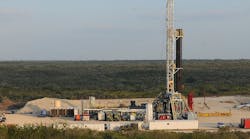View Article as Single page
Drilling & Production — Quick Takes
Aramco to increase drilling rigs by 12% in 2012
Saudi Aramco plans to increase its drilling rig count by 12% next year to 145 to increase production of oil and natural gas from offshore Manifa field, according to an energy analyst.
Most of the expansion is for gas development, said Sadad al-Husseini, a former executive vice-president for exploration and development at Aramco who now runs Husseini Energy.
Al-Husseini said Aramco will drill for gas onshore in northern Saudi Arabia and near Shaybah oil field in the Empty Quarter desert, and offshore in Hasbah field in the Persian Gulf.
He said the Saudi firm expects to have 50 rigs drilling for oil, 50 for gas, 15 exploration rigs, and 30 workover rigs to maintain existing wells during 2012.
The oil drilling is mainly to replace capacity declines that result from ongoing production and will not add new capacity, except for the Manifa drilling, he said.
Aramco increased the number of drilling rigs this year to 130, a higher figure than those supplied by rig contractors, according to al-Husseini.
In March, Baker Hughes Inc. Chief Executive Officer Chad Deaton said Saudi Arabia would increase the number of its drilling rigs by yearend to 118 from 92. Al-Husseini said Aramco is increasing the number of rigs in Manifa field to 20 from 8.
Pacific Drilling receives deepwater drillship
Pacific Drilling SA has taken delivery of the Pacific Santa Ana dual-gradient ultradeepwater drillship, for which Chevron holds a 5-year contract for work in the Gulf of Mexico.
Samsung Heavy Industries of South Korea built the vessel, which has dual load path capability as well as dual-gradient drilling upgrades. The ship can drill to 40,000 ft in as much as 12,000 ft of water.
It's Pacific Drilling's fourth ultradeepwater drillship. The company has two other comparable ships on order with Samsung, both to be delivered in 2013.
Anadarko sanctions Lucius truss spar development
A group led by Anadarko Petroleum Corp. has sanctioned development of the Lucius deepwater discovery in the Gulf of Mexico using a truss spar with a capacity of 80,000 b/d of oil and 450 MMcfd of gas starting in 2014.
The field's reserves of more than 300 million bbl of oil equivalent lie in "relatively shallow and highly productive reservoirs that can be developed in a capital-efficient manner" with off-the-shelf technology, Anadarko said. Lucius would be among the company's most economic projects.
The Lucius unit includes parts of Keathley Canyon Blocks 874, 875, 918, and 919. Anadarko, which operates the unit with a 35% working interest, drilled the discovery well in 2009 in 7,100 ft of water.
Anadarko said Lucius "will establish important infrastructure in an emerging area of the Gulf of Mexico where we have identified additional prospects and opportunities. We expect to have an active drilling program in the unit beginning in 2012, and we look forward to working with our partners to achieve first production in 2014."
Anadarko pioneered truss spar technology in 1997, and Lucius, under construction at Technip's facility in Pori, Finland, will be the largest of company-operated spars.
Following the previously announced unitization agreement, Lucius interest owners entered into an agreement with the Hadrian South coventurers under which natural gas produced from Hadrian South field will be processed through the Lucius facility in return for a production-handling fee and reimbursement for any required facility upgrades (OGJ Online, July 18, 2011).
Other participants in the Lucius unit include Plains Exploration & Production Co. 23.3%, ExxonMobil Corp. 15%, Apache Deepwater LLC 11.7%, Petrobras 9.6%, and Eni 5.4%.
Displaying 3/5
View Article as Single page

